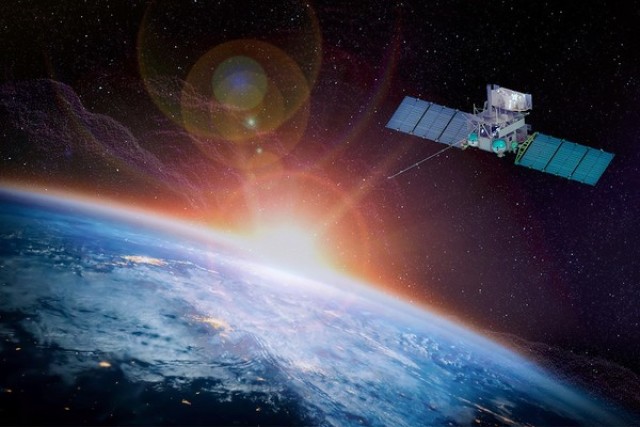The first spacecraft of the new satellite system "Arktika-M", launched at the end of February and has already been sent with the highly elliptical orbit of the unique pictures of the Northern latitudes, also will predict space weather – the holding company "Russian space systems" (part of state Corporation "ROSCOSMOS") was developed and manufactured a unique hardware heliogeophysical complex GGAK-VE, which measures the value of Earth's magnetic field, cosmic streams of electrons and protons. The instruments of the complex installed on the "Arctic-M" will monitor the characteristics of the near-Earth environment during solar flares and geomagnetic storms that affect the propagation of radio waves, the operation of industrial and energy systems, communication equipment and transport pipelines.
The tactical and technical task for the GGAK-VE complex "Arktiki-M" was developed with the participation of Roshydromet. GGAK-VE should provide the Russian economy with advanced data on solar activity, magnetic storms, and radiation conditions in near-Earth space. Space weather affects the conditions of radio communication, the setting of flight restrictions for aircraft pilots, and its timely forecasting will allow you to prepare for accidents on the power grid and exclude events when large-scale power outages occur due to strong magnetic storms.
Alexey KOVALEV, Chief Designer of the RKS Heliogeophysical instrument complex:
The GGAK-VE heliogeophysical instrument complex is designed for continuous acquisition of heliogeophysical data at the altitude of the orbit for monitoring and forecasting the radiation situation in near-Earth space and the state of the geomagnetic field, diagnostics and monitoring of the state of the natural and modified magnetosphere, ionosphere and upper atmosphere of the Earth. Some of the GGAK-VE devices were manufactured inThe Institute of Applied Geophysics named after Academician E. K. Fedorov, their calibration was provided by its metrological service on the previously created distributed reference base. An autonomous heliogeophysical information reception point was also deployed there, passed interdepartmental complex tests and participates in flight tests, which, after switching on the GGAK-VE, enters the Heliogeophysical Service of the Institute in real time.
The Special design Bureau of the Space Research Institute of the Russian Academy of Sciences provided the development and manufacture of the BND-VE interface electronic unit – the GGAK-VE data storage unit, which collects information from the instruments, is responsible for its packaging, storage and discharge to the on-board systems of the Arctic-M.
The D. V. Skobelitsyn Nuclear Research Institute of the Lomonosov Moscow State University has been a key center for nuclear physics research since 1945. For the fundamental and applied study of the nature and nature of cosmic radiation, the instruments of the MSU Research Institute of Nuclear Physics are installed on various satellites – the first sensors still accompanied the flight of dogs into space. The devices of the Russian meteogroup are equipped with devices that provide registration of protons and electrons in a wide energy range from units to hundreds of MeV (megaelectronvolts), that is, from regular cosmic impacts to heavy charged particles.
The research and production enterprise "Astron Electronics" for GGAK-VE developed the FM-VE magnetometric equipment, which consists of sensor blocks located on the remote rod of the spacecraft, and an electronics block. The initial assessment of the received target and telemetry data showed the operability of this GGAK-VE equipment; a comprehensive data assessment will be carried out at the next stages of the Arktiki-M flight tests.
The equipment of the "Arctic-M" has become a further evolution of the onboard systems and target instruments of the meteorological geostationary spacecraft of the "Electro-L" series and is characterized by a wider use of modern domestic components. In addition to the GGAK-VE, the RCS has developed the main target device for the new spacecraft – a multi-zone scanning device, as well as an on-board data collection system, command and measurement systems equipment and an on-board radio engineering complex.
The Arktika-M spacecraft was manufactured by NPO Lavochkina JSC and launched from the Baikonur cosmodrome on February 28, 2021. It is designed for monitoring the hydrometeorological and heliogeophysical conditions of high latitudes, as well as for the operation of the international satellite search and rescue system COSPAS-SARSAT. The creation of Russian satellite systems in highly elliptical orbits is necessary for information support of operational meteorology, heliogeophysics, hydrology, agrometeorology, climate and environmental monitoring in the Arctic region of the Earth.
The space system "Arktika-M" will continuously provide operational information about the state of the atmosphere and the surface of the Arctic region of the Earth to the Hydrometeorological Center of Russia. This will improve the accuracy of models when making short-term weather forecasts, help track emergencies and conduct environmental monitoring of the environment. The new data sets are also planned to be used for scientific purposes for fundamental hydrometeorological research, including the study of the phenomenon of global warming.


